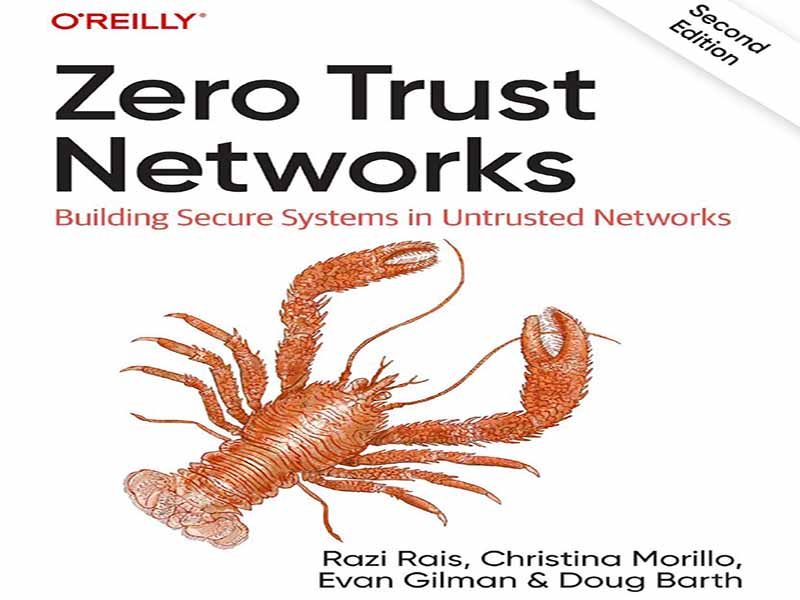- عنوان کتاب: Zero Trust Networks, 2nd edition
- نویسنده: Razi Rais, Christina Morillo, Evan Gilman
- حوزه: امنیت شبکه
- سال انتشار: 2024
- تعداد صفحه: 486
- زبان اصلی: انگلیسی
- نوع فایل: pdf
- حجم فایل: 8.03 مگابایت
از اینکه کتاب «شبکههای بدون اعتماد، ۲E» را برای مطالعه انتخاب کردید، سپاسگزاریم! ساخت سیستمهای قابل اعتماد در شبکههای متخاصم سالهاست که مورد علاقه ما بوده است. در ساخت و طراحی چنین سیستمهایی، با سرعت پیشرفت در جهت حل برخی از مشکلات امنیتی اساسیتر که صنعت ما را درگیر کرده است، مواجه شدهایم. ما بسیار دوست داریم که صنعت با جدیت بیشتری به سمت ساخت سیستمهایی حرکت کند که برای حل این مشکلات تلاش میکنند. به همین منظور، پیشنهاد میکنیم که جهان موضع جدیدی در قبال ساخت و نگهداری شبکههای کامپیوتری امن اتخاذ کند. امنیت به جای اینکه چیزی باشد که در بالا لایه لایه قرار گرفته و تنها پس از ایجاد مقداری ارزش در نظر گرفته شود، باید اساساً با عملکرد خود سیستم عجین شود. باید همیشه وجود داشته باشد و به جای محدود کردن، عملکرد را فعال کند. به این ترتیب، این کتاب مجموعهای از الگوهای طراحی و ملاحظات را ارائه میدهد که در صورت توجه، میتوانند سیستمهایی تولید کنند که در برابر اکثر قریب به اتفاق بردارهای حمله مدرن مقاوم باشند. این مجموعه، در کل، به عنوان مدل بدون اعتماد شناخته میشود. در این مدل، هیچ چیز بدیهی فرض نمیشود و هر درخواست دسترسی – چه توسط یک مشتری در کافیشاپ یا یک سرور در مرکز داده – به طور دقیق بررسی و مجاز بودن آن اثبات میشود. اتخاذ این مدل عملاً حرکت جانبی، سردردهای VPN و سربار مدیریت متمرکز فایروال را از بین میبرد. این یک مدل بسیار متفاوت است؛ مدلی که به اعتقاد ما نمایانگر آینده طراحی امنیت شبکه و زیرساخت است. در ویرایش دوم، دامنه را گسترش میدهیم تا پیشرفتهای اخیر در اعتماد صفر را نیز شامل شود. ما دو فصل کاملاً جدید و سناریوهای دنیای واقعی اضافی را به فصلهای فعلی اضافه کردهایم. فصل مربوط به استانداردها، چارچوبها و دستورالعملهای معماری اعتماد صفر به شما کمک میکند تا دیدگاه اعتماد صفر را از سازمانهای پیشرو مانند NIST، CISA، DoD و دیگران بهتر درک کنید. از آنجایی که ابتکارات اعتماد صفر آسان نیستند، ما فصلی را به بحث در مورد چالشها و توصیههای عملی برای مقابله با آنها اختصاص دادهایم. این فصل با بررسی پیشرفتهای فنی جدیدتر، از جمله هوش مصنوعی، محاسبات کوانتومی و فناوریهای حفظ حریم خصوصی، که همگی به اعتماد صفر و امنیت سایبری به طور کلی بسیار مرتبط هستند، به پایان میرسد. آیا سربار فایروالهای متمرکز را محدودکننده یافتهاید؟ شاید حتی متوجه شدهاید که عملکرد آنها ناکارآمد است. آیا با سردردهای VPN، پیکربندی TLS در میان انبوهی از برنامهها و زبانها، یا سختیهای انطباق و حسابرسی دست و پنجه نرم کردهاید؟ این مشکلات، زیرمجموعه کوچکی از مشکلاتی هستند که مدل اعتماد صفر به آنها میپردازد. اگر فکر میکنید که باید راه بهتری وجود داشته باشد، پس خوش شانس هستید – این کتاب برای شماست. مهندسان شبکه، مهندسان امنیت، مدیران ارشد فناوری و هر کس دیگری میتواند از یادگیریهای اعتماد صفر بهرهمند شود. حتی بدون داشتن مجموعهای از مهارتهای تخصصی، بسیاری از اصول موجود در این کتاب را میتوان به وضوح درک کرد و به رهبران کمک کرد تا در مورد پیادهسازی مدل اعتماد صفر تصمیم بگیرند و وضعیت کلی امنیت خود را به تدریج بهبود بخشند. علاوه بر این، خوانندگانی که تجربه استفاده از سیستمهای مدیریت پیکربندی را دارند، این فرصت را خواهند دید که از همین ایدهها برای ساخت یک سیستم شبکهای امنتر و کارآمدتر استفاده کنند – سیستمی که در آن منابع به طور پیشفرض امن هستند. آنها علاقهمند خواهند بود که چگونه سیستمهای اتوماسیون میتوانند طراحی شبکه جدیدی را فعال کنند که بتواند کنترلهای امنیتی دقیقتری را آسانتر اعمال کند. در نهایت، این کتاب به بررسی یک طراحی کامل و بالغِ مبتنی بر اعتماد صفر میپردازد و کسانی را که از قبل فلسفههای اساسی را در خود گنجاندهاند، قادر میسازد تا استحکام سیستمهای امنیتی خود را افزایش دهند.
Thank you for choosing to read Zero Trust Networks, 2E! Building trusted systems in hostile networks has been a passion of ours for many years. In building and designing such systems, we have found frustration in the pace of progress toward solving some of the more fundamental security problems plaguing our industry. We’d very much like to see the industry move more aggressively toward building systems that strive to solve these problems. To that end, we propose that the world take a new stance toward building and maintaining secure computer networks. Rather than being something that is layered on top, only considered after some value has been built, security must be fundamentally infused with the operation of the system itself. It must be ever-present, enabling operation rather than restricting it. As such, this book sets forth a collection of design patterns and considerations which, when heeded, can produce systems that are resilient to the vast majority of modern-day attack vectors. This collection, when taken as a whole, is known as the zero trust model. In this model, nothing is taken for granted, and every single access request— whether it’s made by a client in a coffee shop or a server in the datacenter— is rigorously checked and proven to be authorized. Adopting this model practically eliminates lateral movement, VPN headaches, and centralized firewall management overhead. It is a very different model; one that we believe represents the future of network and infrastructure security design. In the second edition, we broaden the scope to include recent developments in zero trust. We have added two entirely new chapters and additional realworld scenario walkthroughs to the current chapters. The chapter on zero trust architectural standards, frameworks, and guidelines will help you better grasp the zero trust perspective from leading organizations, such as NIST, CISA, DoD, and others. Since zero trust initiatives are not easy, we added a chapter dedicated to discussing challenges and practical advice to deal with them. This chapter finishes with an examination of more recent technical advancements, including artificial intelligence, quantum computing, and privacy-preserving technologies, all of which are highly relevant to zero trust and cybersecurity in general. Have you found the overhead of centralized firewalls to be restrictive? Perhaps you’ve even found their operation to be ineffective. Have you struggled with VPN headaches, TLS configuration across a myriad of applications and languages, or compliance and auditing hardships? These problems represent a small subset of those addressed by the zero trust model. If you find yourself thinking that there just has to be a better way, then you’re in luck—this book is for you. Network engineers, security engineers, CTOs, and everyone in between can benefit from zero trust learnings. Even without a specialized skill set, many of the principles included in this book can be clearly understood, helping leaders make decisions that implement a zero trust model, improving their overall security posture incrementally. Additionally, readers with experience using configuration management systems will see the opportunity to use those same ideas to build a more secure and operable networked system—one in which resources are secure by default. They will be interested in how automation systems can enable a new network design that is able to apply fine-grained security controls more easily. Finally, this book explores a mature zero trust design, enabling those who have already incorporated the basic philosophies to further the robustness of their security systems.
این کتاب را میتوانید بصورت رایگان از لینک زیر دانلود نمایید.
Download: Zero Trust Networks, 2nd edition




































نظرات کاربران